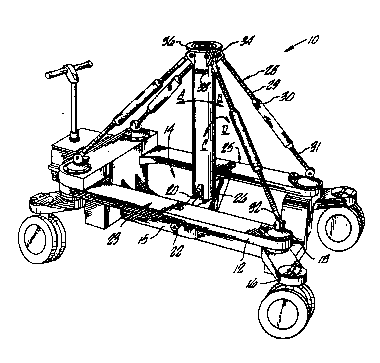Some of the information on this Web page has been provided by external sources. The Government of Canada is not responsible for the accuracy, reliability or currency of the information supplied by external sources. Users wishing to rely upon this information should consult directly with the source of the information. Content provided by external sources is not subject to official languages, privacy and accessibility requirements.
Any discrepancies in the text and image of the Claims and Abstract are due to differing posting times. Text of the Claims and Abstract are posted:
| (12) Patent Application: | (11) CA 2151744 |
|---|---|
| (54) English Title: | CRANE ARM DOLLY |
| (54) French Title: | CHARIOT POUR FLECHE DE GRUE DE CAMERA |
| Status: | Deemed Abandoned and Beyond the Period of Reinstatement - Pending Response to Notice of Disregarded Communication |
| (51) International Patent Classification (IPC): |
|
|---|---|
| (72) Inventors : |
|
| (73) Owners : |
|
| (71) Applicants : |
|
| (74) Agent: | SMART & BIGGAR LP |
| (74) Associate agent: | |
| (45) Issued: | |
| (86) PCT Filing Date: | 1993-12-14 |
| (87) Open to Public Inspection: | 1994-07-07 |
| Availability of licence: | N/A |
| Dedicated to the Public: | N/A |
| (25) Language of filing: | English |
| Patent Cooperation Treaty (PCT): | Yes |
|---|---|
| (86) PCT Filing Number: | PCT/US1993/012163 |
| (87) International Publication Number: | WO 1994014642 |
| (85) National Entry: | 1995-06-13 |
| (30) Application Priority Data: | ||||||
|---|---|---|---|---|---|---|
|
A crane arm dolly (10) for sup-
porting a crane arm carrying a cam-
era includes a post (24) pivotally sup-
ported on a dolly chassis (12). Ad-
justable post support rods (28) sup-
port the post. The support rods can be
lengthened or shortened by use of post
rod adjusters (30) to maintain the post
in a vertical position when the crane
arm dolly is used on an inclined sur-
face.
Note: Claims are shown in the official language in which they were submitted.
Note: Descriptions are shown in the official language in which they were submitted.

2024-08-01:As part of the Next Generation Patents (NGP) transition, the Canadian Patents Database (CPD) now contains a more detailed Event History, which replicates the Event Log of our new back-office solution.
Please note that "Inactive:" events refers to events no longer in use in our new back-office solution.
For a clearer understanding of the status of the application/patent presented on this page, the site Disclaimer , as well as the definitions for Patent , Event History , Maintenance Fee and Payment History should be consulted.
| Description | Date |
|---|---|
| Inactive: IPC from MCD | 2006-03-11 |
| Inactive: IPC from MCD | 2006-03-11 |
| Time Limit for Reversal Expired | 1999-12-14 |
| Application Not Reinstated by Deadline | 1999-12-14 |
| Deemed Abandoned - Failure to Respond to Maintenance Fee Notice | 1998-12-14 |
| Application Published (Open to Public Inspection) | 1994-07-07 |
| Abandonment Date | Reason | Reinstatement Date |
|---|---|---|
| 1998-12-14 |
The last payment was received on 1997-11-26
Note : If the full payment has not been received on or before the date indicated, a further fee may be required which may be one of the following
Please refer to the CIPO Patent Fees web page to see all current fee amounts.
| Fee Type | Anniversary Year | Due Date | Paid Date |
|---|---|---|---|
| MF (application, 4th anniv.) - standard | 04 | 1997-12-15 | 1997-11-26 |
Note: Records showing the ownership history in alphabetical order.
| Current Owners on Record |
|---|
| LEONARD STUDIO EQUIPMENT, INC. |
| Past Owners on Record |
|---|
| LEONARD T. CHAPMAN |